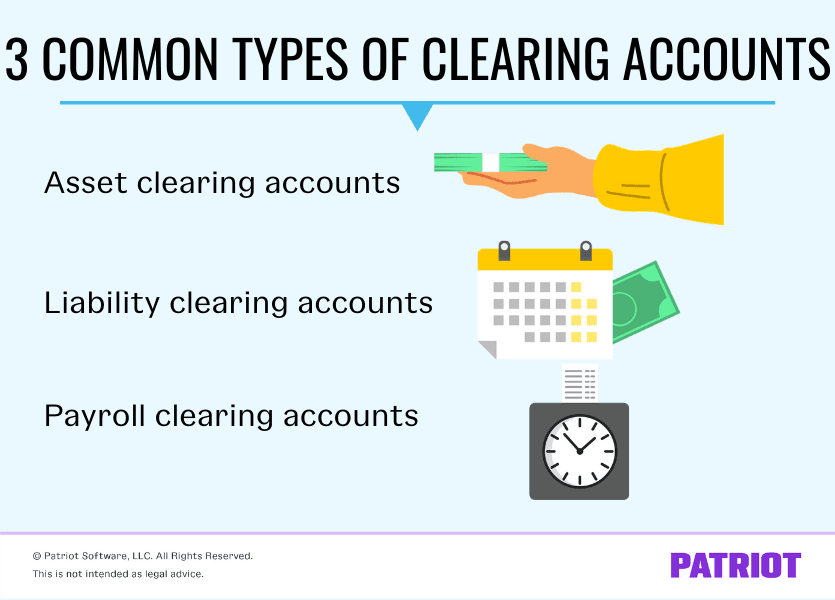If you’re not an accountant, the accounting information you need to know can feel daunting. But, buckle up because there’s another tool you need to understand: clearing accounts. What are clearing accounts? Do you need to use them? What do they do? Clear up your schedule for a few minutes to learn all about clearing accounts.
What is a clearing account?
First and foremost, what in the world is a clearing account? The clearing account definition is that it’s a temporary account containing costs or amounts to be transferred to another account. Clearing accounts are often called a wash account or cash clearing account.
Funds sit in a clearing account for a temporary period until they can be moved where they belong. Generally, you open a clearing account because you cannot classify the funds directly and must wait for more information.
Use a clearing account in your general ledger to record the funds temporarily. Do not add the clearing account amounts to your balance sheet.
Keep in mind that a clearing account is different from a suspense account, though the two are similar temporary accounts. And, remember that the clearing account in your bookkeeping is different from the clearing account you may use for payroll.
What is a suspense account?
Like clearing accounts, suspense accounts record temporary transactions. Use a suspense account to hold entries until you decide how you want to classify them. And, you can hold information about discrepancies in suspense accounts as you compile more information and data.
Wait, that does sound like a clearing account, right? Yes! However, there are notable differences. Open a suspense account in your trial balance, not in your general ledger. And, the suspense account reports balances that do not match between your debits and credits.
So, open a suspense account and hold the funds there as you investigate the discrepancies in your books. Or, you may be unsure of what type of account you should use for a payment or bill. If you’re unsure, speak with your accountant about how to classify your transaction.
Once you determine where to transfer the funds, close the suspense account.
What do clearing accounts do?
Now that you know what a clearing account is, what exactly does it do? Well, this is where things get a little bit trickier.
There are two common types of clearing accounts you may use:
- Asset clearing account: Use an asset clearing account for accounts receivables, such as receiving a payment with no attached invoice. Or, use an asset clearing account for partial payments toward a specific invoice until you receive the invoice amount in full.
- Liability clearing account: Use a liability clearing account for funds you are waiting to transfer to another account, such as funds to pay for an invoice while waiting for the specific invoice to arrive. Or, use a liability clearing account for a bill you’re saving money for that has a lump sum payment at the end of the project.
Both types of clearing accounts allow you to remind yourself of any goods or services you’ve rendered but not officially recorded. Rather than showing funds that are coming in or going out, a cleaning account shows all the funds that are in limbo. When funds are in limbo, you have a record of what you need to know to investigate and classify.
The third most common type of clearing account is the payroll clearing account. But, payroll clearing accounts take two forms:
- A payroll clearing account in your general ledger, OR
- A payroll clearing account in your bank
Payroll clearing accounts in your general ledger act similarly to liability clearing accounts. Bank accounts used as clearing accounts are separate from your general ledger (which we’ll get to later).

Asset clearing account example
Let’s take a look at an example of a scenario where you have receivable information waiting to be classified.
You work with Company A on two projects and send two separate invoices to Company A for the work you performed. So, you have Invoice 1 and Invoice 2. Invoice 1 is for $2,000, and Invoice 2 is for $3,000. But, Company A sent a partial payment of $1,000 and did not attach the invoice.
Because you received a partial payment without an invoice, create an asset clearing account in your general ledger to record the payment. Then, contact Company A to ask for the appropriate invoice number for the payment. After you confirm the information, create a journal entry to move the funds to the correct account with the appropriate invoice.
Liability clearing account example
Again, liability clearing accounts are for funds you owe and are waiting to move to another account. Let’s take a look at a common example of liability clearing accounts.
Let’s say you need a renovation to your shop, so you contract with Company B for $10,000. You create a clearing account for the invoice, which you will receive when Company B completes the work. While Company B works on the project, you move funds to the clearing account. At the end of the project, you have $10,000 in the account waiting for the invoice.
When the invoice arrives, you move the funds from the clearing account to the more specific account in your general ledger for that invoice.
Basically, you “clear out” the temporary account so it has a zero balance when you post everything to the general ledger.
What is a payroll clearing account?
A payroll clearing account is a zero-balance account that you use to record and monitor your payroll. No funds remain in the account after all the checks clear. The account in this scenario is typically a bank account specifically used for holding funds for a temporary amount of time.
The purpose of a payroll clearing account is to enhance security. But, a separate payroll bank account also allows you to reconcile and analyze your books more efficiently.
Let’s say that your payroll totals $10,000 between your employees’ paychecks and all of the taxes. So, you put exactly $10,000 into the payroll clearing account before you pay your employees and deposit the taxes. After your employees deposit their paychecks and you remit the taxes, the balance in the payroll clearing account is $0.00.
You may also have a payroll clearing account in your books where you record payments until you see the payments clear your bank. Once all employees cash or deposit their checks, move the funds from the clearing account to the appropriate account in your books (e.g., Payroll Expense).
Who should use clearing accounts?
Typically, companies with a high volume of funds coming in or going out use clearing accounts. For example, you may have high amounts of payroll, a high volume of invoices, or both.
A steady stream of income can be difficult to keep track of, especially if customers do not attach an invoice or otherwise inform you of what the funds are for. The clearing account lets you track anything that is in transition or you will need to address in the future.
Keep clearing accounts separate based on the type of funds in the account. For example, have an asset clearing account that is separate from a liability clearing account. Do not mix the funds.
Managing your books shouldn’t be a complicated process. Make it easy with Patriot’s online accounting software. Designed to let you manage your books anywhere, anytime, our accounting software gives you the ability to enter invoices, pay bills, and more in a few simple steps. Start your free 30-day trial today!
This is not intended as legal advice; for more information, please click here.


